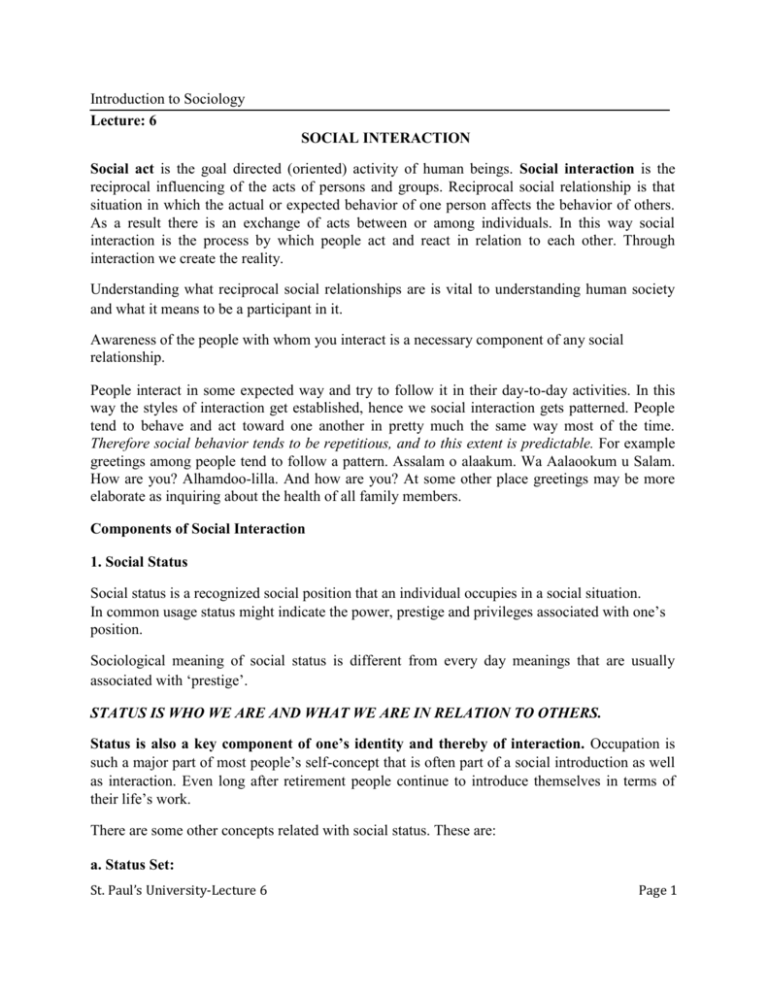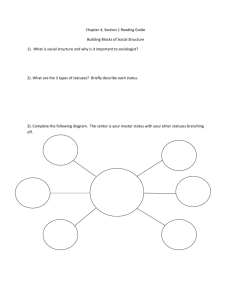Introduction to Sociology Lecture: 6 SOCIAL INTERACTION Social
advertisement

Introduction to Sociology Lecture: 6 SOCIAL INTERACTION Social act is the goal directed (oriented) activity of human beings. Social interaction is the reciprocal influencing of the acts of persons and groups. Reciprocal social relationship is that situation in which the actual or expected behavior of one person affects the behavior of others. As a result there is an exchange of acts between or among individuals. In this way social interaction is the process by which people act and react in relation to each other. Through interaction we create the reality. Understanding what reciprocal social relationships are is vital to understanding human society and what it means to be a participant in it. Awareness of the people with whom you interact is a necessary component of any social relationship. People interact in some expected way and try to follow it in their day-to-day activities. In this way the styles of interaction get established, hence we social interaction gets patterned. People tend to behave and act toward one another in pretty much the same way most of the time. Therefore social behavior tends to be repetitious, and to this extent is predictable. For example greetings among people tend to follow a pattern. Assalam o alaakum. Wa Aalaookum u Salam. How are you? Alhamdoo-lilla. And how are you? At some other place greetings may be more elaborate as inquiring about the health of all family members. Components of Social Interaction 1. Social Status Social status is a recognized social position that an individual occupies in a social situation. In common usage status might indicate the power, prestige and privileges associated with one’s position. Sociological meaning of social status is different from every day meanings that are usually associated with ‘prestige’. STATUS IS WHO WE ARE AND WHAT WE ARE IN RELATION TO OTHERS. Status is also a key component of one’s identity and thereby of interaction. Occupation is such a major part of most people’s self-concept that is often part of a social introduction as well as interaction. Even long after retirement people continue to introduce themselves in terms of their life’s work. There are some other concepts related with social status. These are: a. Status Set: St. Paul’s University-Lecture 6 Page 1 Status set refers to all the statuses a person holds at a given time. You might be a son/daughter of your parents, a brother/sister to your siblings, a friend to your social circle, a player in a team. Then in life you occupy other status sets by virtue of your occupation, marital status (husband/wife), and a parent. Over lifetime, individuals gain and lose dozens of statuses. How do we attain our status? Broadly two ways and thereby these are called two types of statuses. b. Ascribed and Achieved Status A social position that someone receives at birth or someone assumes involuntarily later in life is an ascribed status. These are those statuses about which one has little or no choice. Examples can be a son, a Kenyan, a teenager. Achieved status refers to a social position that someone assumes voluntarily and that reflects personal ability and effort. Examples include being a student, a player, a spouse, and a singer. Many statuses are a combination of both an ascription and achievement. People’s ascribed statuses influence the statuses they achieve. A person’s social class influences his/her occupational achievements. C. Master Status A master status is a status that has an exceptional importance for social identity, often shaping a person’s entire life. One’s occupation is an example. 2. ROLE Role is a behavior expected of someone who holds a particular status. Role is the dynamic aspect of one’s status: an individual holds a status and performs a role. There are a number of other aspects of role like: a. Role Set Since we occupy many statuses simultaneously therefore we perform multiple roles. The performance of such multiple roles related to a status is referred to as role set. Role set refers to a number of roles attached to a single status. You have a status of student, think of how many roles do you have to perform. b. Role Conflict and Role Strain Role conflict is incompatibility among roles corresponding to two or more statuses. Roles of a woman being a mother and an employee in an office may conflict with each other. St. Paul’s University-Lecture 6 Page 2 Roles connected with a single status may make competing demands on an individual, therefore may create strain in the performance of those roles simultaneously. Hence role strain refers to incompatibility among roles corresponding to a single status. A teacher being friendly with the students as well as the maintainer of discipline in the class could be an example. c. Role Exit A person begins the process of role exit by reflecting on his life and coming to doubt his ability to continue in a certain role. He may imagine alternative role and may go for it. It may be linked status exit, which may be voluntary or involuntary. A person decides to leave a job voluntarily and has a role exit. A person retires and again has a role exit. “Process of becoming ex”, an exchairman, an ex-director are the examples. 3. The Social Construction of Reality Reality of one’s self. We construct our reality. Let me explain. I enter this room and immediately I become what I have to become, what I can become. I construct my self. That is, I present myself to you in a form suitable to the relationship I wish to achieve with you. And, of course, you do the same with me. The whole of this process of construction of one’s self/reality is based on learning through social interaction. Social construction of reality is the process by which people creatively shape reality through interaction. Through social interaction we negotiate the reality i.e. some agreement about what is going on, though people may have different perceptions of the event. Social construction of the life span of people into childhood, adulthood, and old age can be the examples. Situations that we define as real become real in their consequences or in their being functional. Reality as perceived by the people as they have constructed. What is the reality of a commonly used phrase: How are you? Do we mean physically? Mentally? Spiritually? Financially? 4. Communication Communication is another important component of interaction for which we need to have a language – verbal as well as non-verbal. Human beings develop symbols, signs, and codes that they associate with the realities of life. These signs, symbols, and codes stand for the reality or phenomenon (material/non material), they are not the phenomenon itself. Meanings are attached to the symbols and there is some agreement on the meanings. Meanings can be situation specific and may vary by different cultures. St. Paul’s University-Lecture 6 Page 3











